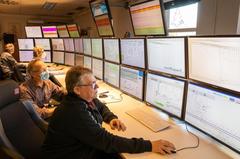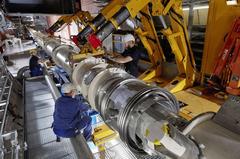URL: https://www.desy.de/news/news_search/index_eng.html
Breadcrumb Navigation
DESY News: ALPS magnets cooled down to minus 269 degrees
News
News from the DESY research centre
ALPS magnets cooled down to minus 269 degrees
The superconducting magnets used in the ALPS II experiment have cooled down to their operating temperature of minus 269 degrees Celsius. With this, ALPS II has completed an important step in its commissioning. After an interruption of more than 14 years, helium is once again flowing through the HERA tunnel that houses the experiment. ALPS II spokesperson Axel Lindner is impressed by his team: “ALPS is a perfect example of interdisciplinary collaboration between highly motivated younger colleagues and more experienced scientists, some of whom have also contributed their experience with HERA. Thanks to this fantastic team, we have overcome all the difficulties and maintained our promising course in the search for dark matter.”

The cryogenic team controlled the cooling of the ALPS II magnets from the control room of the cryo hall. Photo: DESY, Marta Mayer
The “light-shining-through-a-wall” experiment ALPS (Any Light Particle Search) is hoping to detect extremely light particles that could make up dark matter. The international team is using twenty-four recycled HERA magnets, laser beams and an extremely sensitive detector to search for these so-called axion-like particles. They rely on the principle that in a strong magnetic field, photons – i.e. particles of light – could be transformed into these mysterious particles, and then back again. The first half of the HERA magnets are arranged in a straight line enclosing a vacuum tube in which a high-intensity laser beam bounces back and forth. If a photon turned into an axion, it would be able to pass through an opaque wall located at the end of the line of magnets. Having passed through it, the axion could than change back into light as it travelled down an almost identical magnetic path on the other side, and this photon would then be captured by the detector at the end.
Since the last of the ALPS magnets was installed in the tunnel, about a year ago, the superconducting cables for the individual modules have been connected up, as have the cryogenic pipes and the vacuum insulation. The modules were connected to the power supply and to the cryogenic system, to be filled with liquid helium. After the system that supplies the HERA magnets had passed a pressure test conducted by the technical supervisory authorities, at the beginning of November, the operators of the cryogenic system opened the helium valves on 20 November to cool the magnets down by around 300 degrees. Finally, on 15 December, the stable state of 4.2 Kelvin (-269 degrees Celsius) was reached.
“The mode of operation is exactly the same as for HERA,” says Detlef Sellmann from the DESY Cryoteam. “The magnetic coils are now completely surrounded by single-phase supercritical helium, which is kept cold by the controlled evaporation of helium.”

Just over a year ago, the last of the superconducting ALPS magnets were installed in the tunnel. In the meantime, minus 269 degrees Celsius helium flows through the entire chain. Photo: DESY, Heiner Müller-Elsner
In order to test the stability of the optical components, the experiment, which has an overall length of about 250 metres, currently still consists of a single light path stretching along its entire length. The mirrors and the wall that are to be placed in the middle of the apparatus, completing the optical system, will only be installed at a later date. The next step will be to test how the superconducting magnets behave when some 5600 amperes of current are flowing through their coils as they generate their strong magnetic field. Data collection is then scheduled to begin in the summer of 2022.



